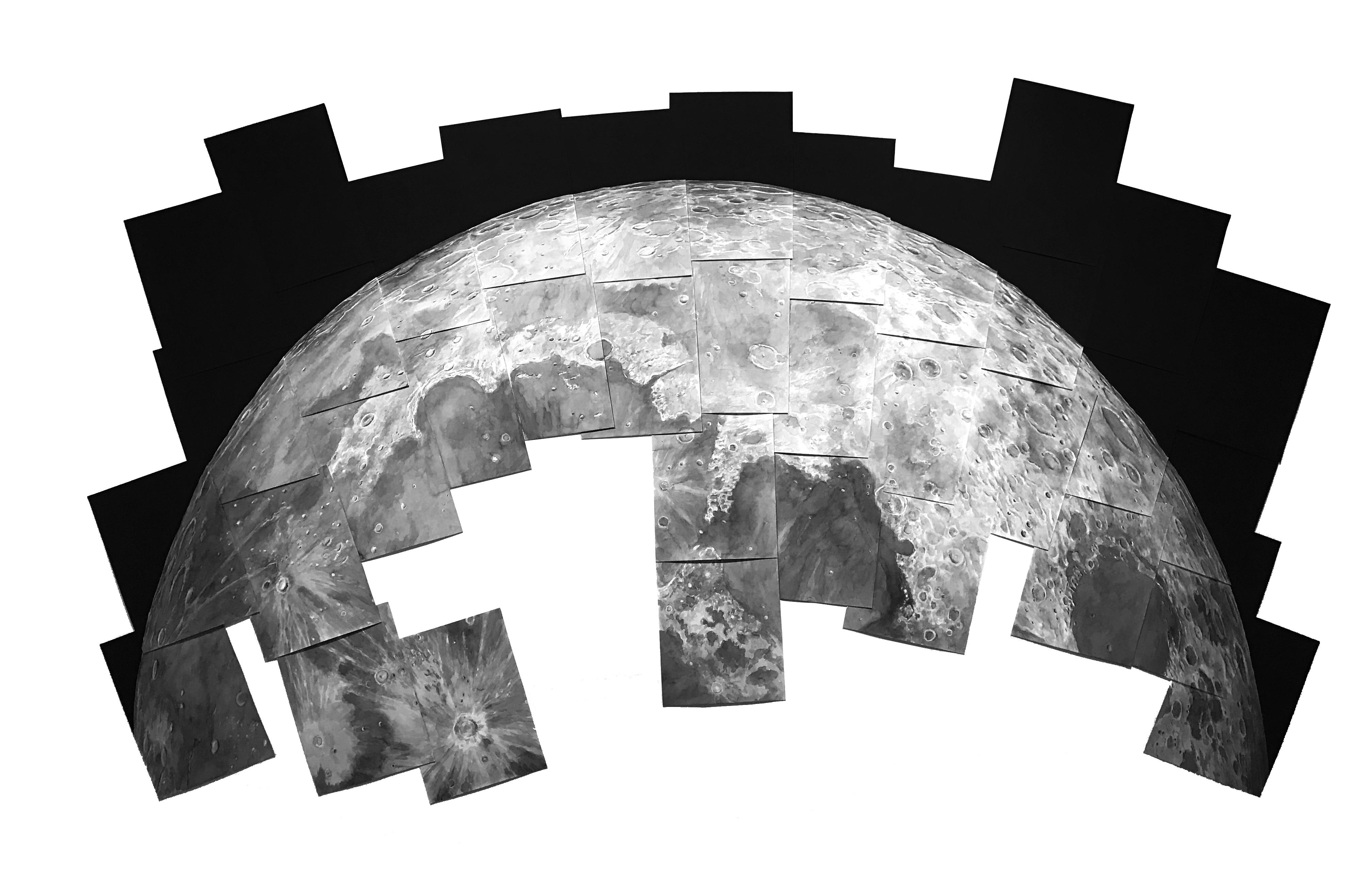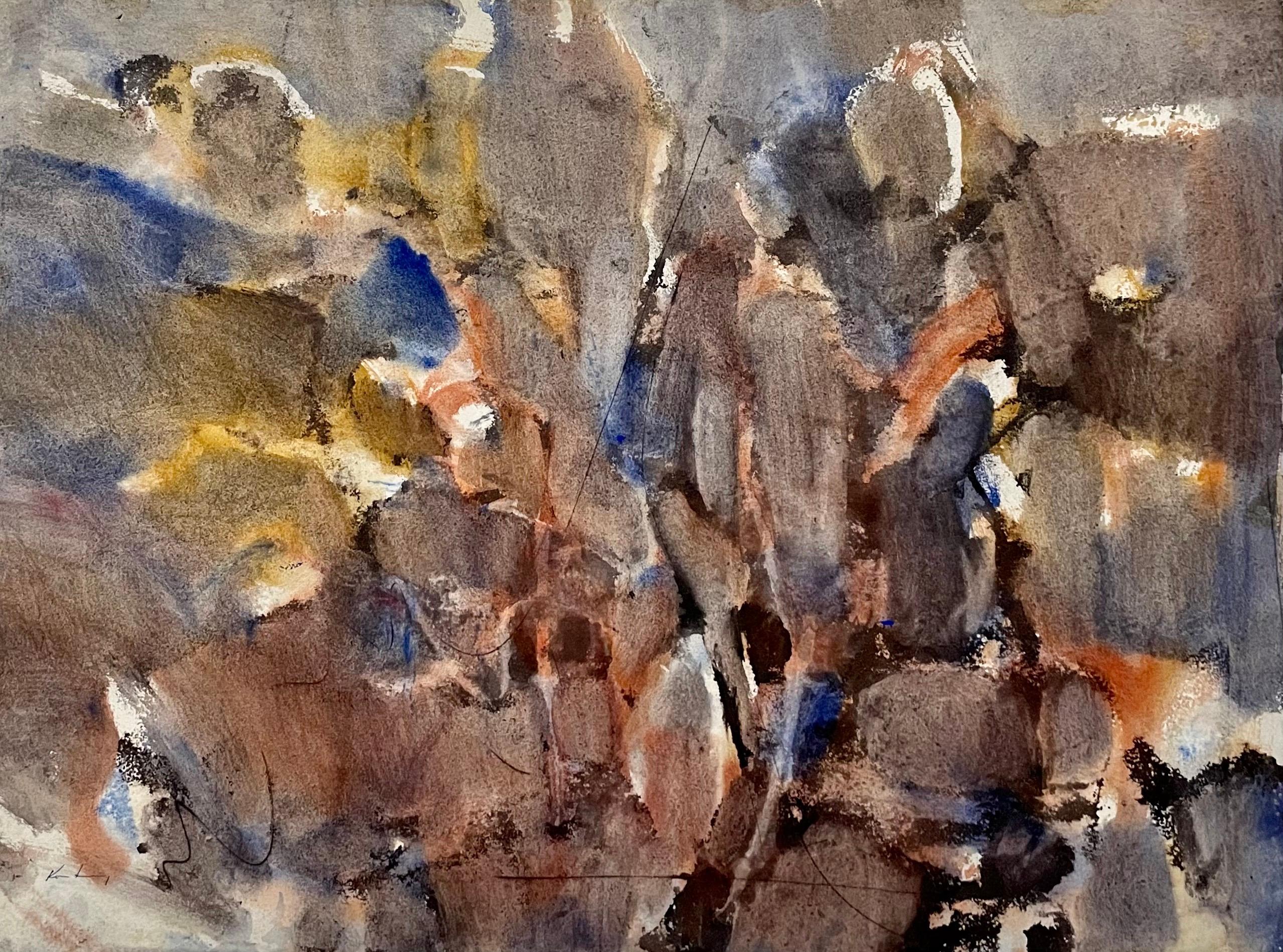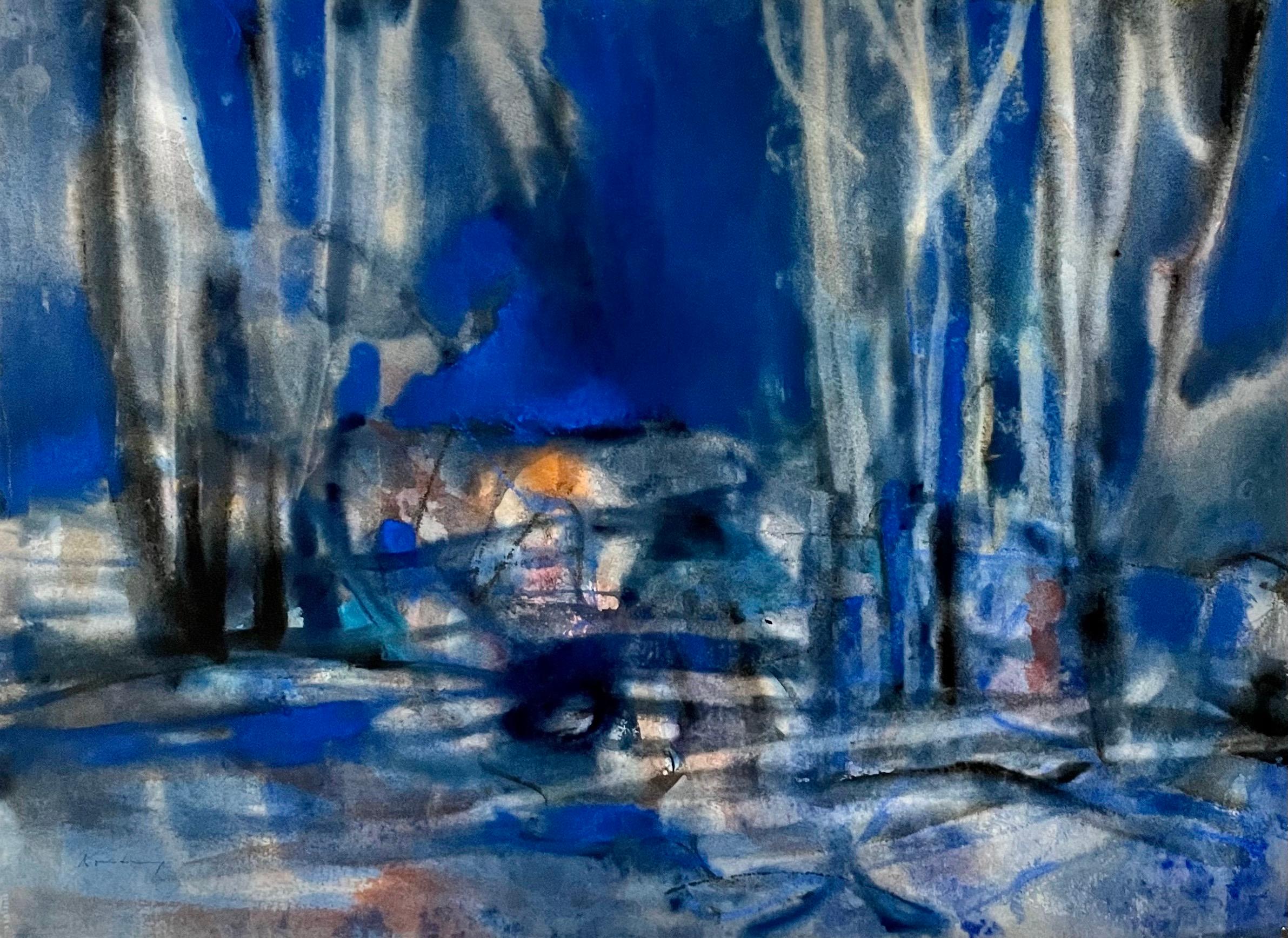Items Similar to Rosie Phipps, Cotswolds Landscape, Contemporary painting for sale, Abstract art
Want more images or videos?
Request additional images or videos from the seller
1 of 7
Rosie PhippsRosie Phipps, Cotswolds Landscape, Contemporary painting for sale, Abstract art
About the Item
Cotswold landscape
Rosie Phipps
Landscape mixed media
Framed Size: W 40cm x H 23cm
Mounted Size: W 34.5cm x H 19cm
Image Size: W 25cm x 10cm
£250
Rosie says: ‘Painting is rather like a journey. One never knows if the journey will be short or long. Pleasurable or painful. One has to be able to manage the distress and discomfort. Hopefully in making the journey, rather like a pilgrimage, one hopes to be remade in some way.Reaching a new land. A new way of being and seeing. A promised land. And of course the ultimate prize is when one realises that one has created something that has never existed before.It has not been copied. It is not an imitation of what has gone before. The brushstrokes that are there only exist because they have been seen by the artist in a particular way. It is their mark. Only their eyes have seen it. It is a private revelation and comes as a complete surprise.
- Creator:
- Dimensions:Height: 9.06 in (23 cm)Width: 15.75 in (40 cm)
- Medium:
- Period:
- Condition:
- Gallery Location:Deddington, GB
- Reference Number:1stDibs: LU63234797211
About the Seller
5.0
Platinum Seller
These expertly vetted sellers are 1stDibs' most experienced sellers and are rated highest by our customers.
Established in 2014
1stDibs seller since 2017
968 sales on 1stDibs
Typical response time: 1 hour
- ShippingRetrieving quote...Ships From: Deddington, United Kingdom
- Return PolicyA return for this item may be initiated within 14 days of delivery.
More From This SellerView All
- Trevor Waugh, Waiting Gondolas Venice, Original Watercolour Painting, LocationBy Trevor WaughLocated in Deddington, GBWaiting Gondolas Venice, Trevor Waugh Original Unframed Watercolour Painting Watercolour on Paper Size: H 38.1cm (15 inches) x W 55.88cm (22 inches) Ple...Category
21st Century and Contemporary Landscape Paintings
MaterialsWatercolor, Archival Paper
- Trevor Waugh, Walls of Marrakech, Original Framed Watercolour PaintingBy Trevor WaughLocated in Deddington, GBWalls of Marrakech, Trevor Waugh Original Framed Watercolour Painting Watercolour and Paper Image Size: H 30.5cm (12 inches) x W 38.1cm (15 ...Category
21st Century and Contemporary Landscape Paintings
MaterialsWatercolor, Archival Paper
- Trevor Waugh, The Old Studio, Original Framed Watercolour Painting, Floral ArtBy Trevor WaughLocated in Deddington, GBThe Old Studio, Trevor Waugh Original Framed Watercolour Painting Watercolour on Paper Image Size: H 38.1cm (15 inches) x W 53.35cm (21 inches) Framed Siz...Category
21st Century and Contemporary Landscape Paintings
MaterialsWatercolor, Archival Paper
- Rosie Phipps, The Cotswolds on a fine day, Landscape Painting, Original ArtBy Rosie PhippsLocated in Deddington, GBThe Cotswolds on a fine day Rosie Phipps Water colour, Gouache, Pastel 40 cm x 23 cm Pass into the landscape looking first into the far distance, and then taking one’s gaze to the m...Category
21st Century and Contemporary Landscape Paintings
MaterialsWatercolor, Archival Paper
- Sprinting Ahead Garth Bayley Horse racing art, Equine Art, Affordable Bright ArtBy Garth BayleyLocated in Deddington, GBGarth Bayley Sprinting Ahead. Garth Bayley. Pen and ink on watercolour paper Watercolour Paint on Canvas Board Image size: H 25cm x W32 cm x 0.1 cm Sold Unframed Please note that in ...Category
21st Century and Contemporary Landscape Paintings
MaterialsWatercolor, Archival Paper
- Rosie Phipps, The Cotswolds, Paintings of Oxfordshire, Cotswold Art, Bright ArtBy Rosie PhippsLocated in Deddington, GBRosie Phipps The Cotswolds Original Watercolour Painting Watercolour Paint on Paper Image Size: H 10cm x W 25cm x D 0.1cm Mount Size: H 19cm x W 34cm x D 0.3cm Framed Size: H 23cm x ...Category
21st Century and Contemporary Impressionist Landscape Paintings
MaterialsWatercolor, Archival Paper
You May Also Like
- "Andromeda" Large Scale Watercolor Galaxy painting by Thomas BroadbentBy Thomas BroadbentLocated in New York, NYAt over 11 feet in length, Broadbent’s “Andromeda” galaxy watercolor painting captures the spectacle and wonder one feels when looking at the stars in the night sky. In this large sc...Category
2010s Contemporary Landscape Paintings
MaterialsWatercolor, Archival Paper
- "Moon Arc", Multi-panel black and white watercolor painting installationBy Thomas BroadbentLocated in New York, NY87"x149" multi-panel installation. This watercolor painting installation is created on 36 paper panels and is inspired by a view of the moon. The dee...Category
2010s Contemporary Landscape Drawings and Watercolors
MaterialsWatercolor, Archival Paper
- La Baie des Anges a Nice et le Casino 1928 gouache Palm Trees, Horse & CarriageBy Raoul DufyLocated in Rancho Santa Fe, CALa Baie des Anges a Nice et le Casino is a lovely gouache on paper from 1928. The work is fully authenticated by Fanny Guillon-Laffaille and is listed in the Raoul Dufy Catalogue Rai...Category
1920s Post-Impressionist Landscape Paintings
MaterialsGouache, Archival Paper
- Vu d'ici - Watercolour, Painting on paper, Landscape, SeasideLocated in AIX-EN-PROVENCE, FRWatercolour, Acrylic Painting on archival paper. Work Title : "Vu d'ici" (EN : Seen from here) Artist : Fabien Granet (FR) The work is signed and dated on the back of the work. Uniq...Category
21st Century and Contemporary Contemporary Landscape Paintings
MaterialsWatercolor, Acrylic, Archival Paper
- Large Modernist Abstract Expressionist Watercolor Painting Bauhaus Weimar ArtistBy Pawel KontnyLocated in Surfside, FLAbstract watercolor composition bearing the influence of the earlier color-block compositions of Paul Klee. Pawel August Kontny, (Polish-German-American artist) He was born in Laurahuette, Poland, in 1923, the son of a wealthy pastry shop owner. In 1939 he began studying architecture in Breslau where he was introduced to the European masters and to the work of some of the German Expressionists, soon afterward banned as "degenerate artists" and removed from museums throughout Germany by the Nazi regime. His studies were interrupted by World War II. Drafted into the German army, traveling in many countries as a soldier, he sketched various landscapes but in 1945, he was captured and held as a prisoner of war in Italy. After the war, he studied at the Union of Nuremberg Architects to help design buildings to replace ones destroyed in the war. He recorded his impressions of the local population and the landscapes through his watercolors and drawings. Pawel Kontny thereafter moved to Nuremberg, Germany, becoming a member of the Union of Nuremberg Architects and helping to rebuild the city's historic center. He soon decided to concentrate on his professional art career. He married Irmgard Laurer, a dancer with the Nuremberg Opera. Pavel Kontny 's career as an artist was launched with his participation in an all German exhibition, held at the Dusseldorf Museum in 1952. He held one-man shows in Germany, Switzerland and the United States. During his trip to the United States in 1960, Kontny became instantly enamored with Colorado, and decided to relocate to Cherry Hills with his wife and two children. He quickly established himself in the local art community, being affiliated for a time with Denver Art Galleries and Saks Galleries. His subject matter became the Southwest. During this time he received the Prestigious Gold Medal of the Art Academy of Rome. His extensive travel provided material for the paintings he did using his hallmark marble dust technique. he also worked equally in pastel, watercolor, charcoal and pencil-and-ink. in a style which merged abstraction and realist styles, influenced by Abstract Expressionist painting and South Western American landscapes. In the early 1960s he was one of only a few European-born professional artists in the state, a select group that included Herbert Bayer (1900-1985), a member of the prewar Bauhaus in Weimar and Dessau, Germany, and Roland Detre (1903-2001), a Hungarian modernist painter. As a Denver, Colorado resident, Pavel Kontny exhibited at galleries and museums throughout the United States, Germany and Japan. There, he was inspired by frequent trips to Native American pueblos in the Southwest, as well as by the study of the Plains Indians of Montana and Wyoming. Over the years Kontny had a number of students and generously helped young artist by hosting exhibitions at his Cherry Hills home. For many years he generously donated his paintings to support charitable causes in Denver. Influences during his European years included German pastelist C.O. Muller, German Informel painter Karl Dahmen and Swiss artist, Hans Erni. In the early 1950s his painting style showed the influence of the Die Brücke (The Bridge), a group of German expressionist artists formed in Dresden in 1905 who had a major impact on the evolution of modern art in the twentieth century in Germany. By the middle of the decade his style incorporated more referential abstraction and total abstraction, resulting in part from his study of Hans Hartung, a German artist based in Paris who exhibited his gestural abstract work in Germany. The American moon landing in 1969 inspired Paul Kontny...Category
Mid-20th Century Abstract Expressionist Landscape Paintings
MaterialsWatercolor, Archival Paper
- Large Modernist Abstract Expressionist Gouache Painting Bauhaus Weimar ArtistBy Pawel KontnyLocated in Surfside, FLAbstract watercolor or gouache composition bearing the influence of the earlier color-block compositions of Paul Klee. Pawel August Kontny, (Polish-German-American artist) He was born in Laurahuette, Poland, in 1923, the son of a wealthy pastry shop owner. In 1939 he began studying architecture in Breslau where he was introduced to the European masters and to the work of some of the German Expressionists, soon afterward banned as "degenerate artists" and removed from museums throughout Germany by the Nazi regime. His studies were interrupted by World War II. Drafted into the German army, traveling in many countries as a soldier, he sketched various landscapes but in 1945, he was captured and held as a prisoner of war in Italy. After the war, he studied at the Union of Nuremberg Architects to help design buildings to replace ones destroyed in the war. He recorded his impressions of the local population and the landscapes through his watercolors and drawings. Pawel Kontny thereafter moved to Nuremberg, Germany, becoming a member of the Union of Nuremberg Architects and helping to rebuild the city's historic center. He soon decided to concentrate on his professional art career. He married Irmgard Laurer, a dancer with the Nuremberg Opera. Pavel Kontny 's career as an artist was launched with his participation in an all German exhibition, held at the Dusseldorf Museum in 1952. He held one-man shows in Germany, Switzerland and the United States. During his trip to the United States in 1960, Kontny became instantly enamored with Colorado, and decided to relocate to Cherry Hills with his wife and two children. He quickly established himself in the local art community, being affiliated for a time with Denver Art Galleries and Saks Galleries. His subject matter became the Southwest. During this time he received the Prestigious Gold Medal of the Art Academy of Rome. His extensive travel provided material for the paintings he did using his hallmark marble dust technique. he also worked equally in pastel, watercolor, charcoal and pencil-and-ink. in a style which merged abstraction and realist styles, influenced by Abstract Expressionist painting and South Western American landscapes. In the early 1960s he was one of only a few European-born professional artists in the state, a select group that included Herbert Bayer (1900-1985), a member of the prewar Bauhaus in Weimar and Dessau, Germany, and Roland Detre (1903-2001), a Hungarian modernist painter. As a Denver, Colorado resident, Pavel Kontny exhibited at galleries and museums throughout the United States, Germany and Japan. There, he was inspired by frequent trips to Native American pueblos in the Southwest, as well as by the study of the Plains Indians of Montana and Wyoming. Over the years Kontny had a number of students and generously helped young artist by hosting exhibitions at his Cherry Hills home. For many years he generously donated his paintings to support charitable causes in Denver. Influences during his European years included German pastelist C.O. Muller, German Informel painter Karl Dahmen and Swiss artist, Hans Erni. In the early 1950s his painting style showed the influence of the Die Brücke (The Bridge), a group of German expressionist artists formed in Dresden in 1905 who had a major impact on the evolution of modern art in the twentieth century in Germany. By the middle of the decade his style incorporated more referential abstraction and total abstraction, resulting in part from his study of Hans Hartung, a German artist based in Paris who exhibited his gestural abstract work in Germany. The American moon landing in 1969 inspired Paul Kontny...Category
20th Century American Modern Landscape Paintings
MaterialsWatercolor, Archival Paper
Recently Viewed
View AllMore Ways To Browse
Cotswolds Painting
Cotswold Landscape
Painting Of The Cotswold
Art By Rosie
Vintage Vineyard
China Landscape Painting Mountains
J Boats
Maine Beach
Maritime Boat
Railroad Painting
Southwestern Landscape Paintings
Swamp Art
Swedish Modernist Artist
Switzerland Mountain Landscape
Union Church
Vintage Gardens Paintings
A Motor Oil
Cape May Art





